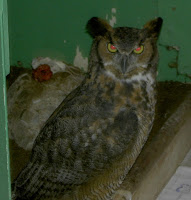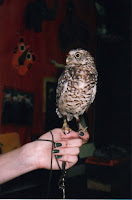When thinking about what to write for the letter O a lot of ideas came to mind but none that I would consider worthy of a blog post. I asked my husband for some help and "O is for Ornithology" was 'born.'
Ornithology is the scientific study of birds. I am going to include in my definition: the study, appreciation, and conservation of birds. I have several bird identification books, books about different types of birds of prey, and a few pairs of binoculars. I was also fortunate when I worked at the zoo to be able to handle many different types of birds for our education classes. Furthermore, my stepson has had the opportunity to bird-watch with his maternal grandmother several times over the years. Highlights for him include seeing cardinals and a bald eagle.
There are many great resources for people interested in Ornithology including:
The Cornell Lab of Ornithology
American Museum of Natural History
On my journeys, I have been able to see many different types of birds such as cormorants, pelicans, herons, mallards, blue jays, robins, house wrens, chickadees, and others. I think one of my favorite birds to spot would be those in the Picidae family: woodpeckers. We have northern flickers, pileated woodpeckers, and downy woodpeckers where I live.
I was able to handle many varieties of birds at the zoo, including chickens, ducks, a red-tailed hawk, burrowing owls, a great horned owl, macaws, and a Senegal parrot.
 |
| Great Horned Owl |
 |
| I am holding a burrowing owl. |
Owls are mainly nocturnal predators with large eyes and large facial disks. Some owls have asymmetrical ear holes (with one ear hole higher on the skull than the other), which enable them to pinpoint where its prey is, beneath them as they fly. Other features of owls that add in hunting are the shape and position of the eyes and the extra vertebrae in their necks that enable them to turn their head 270º.
 |
| Guinea fowl in the children's zoo. |
I was also known as one of the few education staff members who would regularly request to exhibit guinea fowl for my classes. Most chose not to use them because the call of guinea fowl is quite loud (especially when in a carrier being transported in a vehicle). I just loved being able to introduce children to a unique bird that many locals actually raise on farms because they will eat ticks. Farmers in Africa like having guinea fowl because that loud call alerts them to dangers to their herd of cattle, sheep, or goats.
 |
| I am holding a Senegal Parrot. |
Another type of bird I enjoy are parrots including macaws, an African Gray parrot, eclectus parrot, and a Senegal parrot. They all had their own unique personalities much like people do. Our different macaws preferred some educators over others, our African Gray parrot definitely had favorites, and even our young eclectus parrot chose for whom she would behave while on program. This is one of the many reasons why I would not recommend a parrot to someone without their first doing lots of research of the pros and cons for parrot ownership.
 |
| Stuffed Snowy Owl and Cooper's Hawk (both died of natural causes) |
Resources
There are photographs of owls, skulls, sketches of their skeletal system, and more.
This site provides much of the information available in their field guides including bird sounds, articles, and ways to take action for bird conservation.
Note: All photographs by myself or my mom.
I have copies of the following books (although I own the first edition of the Sibley Guide to Birds).
I particularly like the Beginners guide because it is actually organized by color.
I have copies of the following books (although I own the first edition of the Sibley Guide to Birds).
I particularly like the Beginners guide because it is actually organized by color.



My boys and I have had such a great time studying birds since we began homeschooling.
ReplyDeleteThey are such awesome creatures. If we lived were we could have chickens, I would love to have some (and probably ducks as well).
DeleteI'm going to have to share this with my bird-loving girl. She just finished a bird study so she'll enjoy seeing this and checking out a couple of the links. - Lori
ReplyDeleteCool! Thank you for sharing. :)
Delete